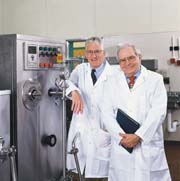
Q: What mix processing variables impact the eating quality of ice cream?
A: Unit operations up to, but not including whipping and freezing, are considered mix processing. All mix processing variables have significant and complex influence on the eating quality (body, texture and flavor) of ice cream. It is possible here to provide only a broad overview of the relationships involved. Many of these have been considered in greater detail in previous columns. All are addressed in detail at Tharp & Young On Ice Cream technical short courses.To start, mix ingredients should have maximum stability with regard to flavor, functionality and, in the case of protein-containing ingredients, protein stability. These elements are particularly vulnerable to deterioration due to the heat and shear applied during processing.
When dispersing ingredients, the use of high-speed mixers should be limited so that no more agitation than necessary is applied; otherwise, protein and fat molecules might become unstable. This can negatively affect mix stability and fat agglomeration in the freezer.
Exceeding pasteurization specifications (time/temperature) can cause quality variations with regard to flavor, color and protein stability. For example, cooked flavors might develop, which can become a problem when cooked flavor is not a normal part of the finished product's flavor profile. Color can deteriorate as well. And, protein molecules can be damaged, particularly when protein stability has been diminished in one or more dairy ingredients. In the extreme, protein instability produces serum separation in the package and/or a meltdown that is curdy and shows whey separation.
Following pasteurization, it is important to cool the mix to 40


